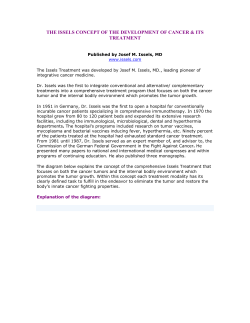
BREAKING ADVANCES
Cancer Research Table of Contents October 15, 2014 Volume 74 Number 20 BREAKING ADVANCES 5681 5723 Highlights from Recent Cancer Literature Katherine H. Parker, Pratima Sinha, Lucas A. Horn, Virginia K. Clements, Huan Yang, Jianhua Li, Kevin J. Tracey, and Suzanne Ostrand-Rosenberg REVIEW 5683 Precis: A secreted alarmin that is ubiquitously present in the tumor microenvironment provides a pivotal proinflammatory contribution to the differentiation and suppressive potency of myeloid-derived suppressor cells, an important driver of immune escape in many solid tumors. DEAR1, a Novel Tumor Suppressor That Regulates Cell Polarity and Epithelial Plasticity Nanyue Chen, Seetharaman Balasenthil, Jacquelyn Reuther, and Ann McNeill Killary 5734 INTEGRATED SYSTEMS AND TECHNOLOGIES 5690 5700 Cytokine-like Molecule CCDC134 Contributes to CD8þ T-cell Effector Functions in Cancer Immunotherapy Novel Drug Candidates for the Treatment of Metastatic Colorectal Cancer through Global Inverse Gene-Expression Profiling Jing Huang, Lin Xiao, Xiaoting Gong, Wenwei Shao, Yanhui Yin, Qinyuan Liao, Yang Meng, Yingmei Zhang, Dalong Ma, and Xiaoyan Qiu Vera van Noort, Sebastian Sch€ olch, Murat Iskar, Georg Zeller, Kristina Ostertag, Christine Schweitzer, Kristin Werner, J€ urgen Weitz, Moritz Koch, and Peer Bork Precis: These findings offer strong evidence for a new member of the gc cytokine family that provides powerful support for CD8þ T-cell–mediated immunity, with potential implications for therapeutic applications. Precis: These findings provide a rationale to reposition the antidepressant drug citalopram for treatment of late-stage colorectal cancers, with immediate implications for clinical evaluation of this drug. MOLECULAR AND CELLULAR PATHOBIOLOGY 5746 Development of Novel ADCs: Conjugation of Tubulysin Analogues to Trastuzumab Monitored by Dual Radiolabeling Metastatic Consequences of Immune Escape from NK Cell Cytotoxicity by Human Breast Cancer Stem Cells Bin Wang, Qiang Wang, Zhe Wang, Jun Jiang, Shi-Cang Yu, Yi-Fang Ping, Jing Yang, Sen-Lin Xu, Xian-Zong Ye, Chuan Xu, Lang Yang, Cheng Qian, Ji Ming Wang, You-Hong Cui, Xia Zhang, and Xiu-Wu Bian Ruth Cohen, Danielle J. Vugts, Gerard W.M. Visser, Marijke Stigter-van Walsum, Marije Bolijn, Marco Spiga, Paolo Lazzari, Sreejith Shankar, Monica Sani, Matteo Zanda, and Guus A.M.S. van Dongen Precis: These findings reveal how metastasis-initiating breast cancer stem-like cells evade immune surveillance by natural killer cells. Precis: Radiolabeling both a synthetic tubulysin and the antibody to which it is attached facilitated preclinical validation of a new antibody-drug conjugate (ADC) with excellent tumor-targeting performance and efficacy. 5758 MICROENVIRONMENT AND IMMUNOLOGY 5711 HMGB1 Enhances Immune Suppression by Facilitating the Differentiation and Suppressive Activity of Myeloid-Derived Suppressor Cells Cellular Disposal of miR23b by RAB27Dependent Exosome Release Is Linked to Acquisition of Metastatic Properties Marie Stampe Ostenfeld, Dennis K. Jeppesen, Jens R. Laurberg, Anders T. Boysen, Jesper B. Bramsen, Bjarke Primdal-Bengtson, An Hendrix, Philippe Lamy, Frederik Dagnaes-Hansen, Mads H. Rasmussen, Khan H. Bui, Niels Fristrup, Erik I. Christensen, Iver Nordentoft, Jens P. Morth, Jørgen B. Jensen, Jakob S. Pedersen, Martin Beck, Dan Theodorescu, Michael Borre, Kenneth A. Howard, Lars Dyrskjøt, and Torben Falck Ørntoft Adiponectin Receptor Signaling on Dendritic Cells Blunts Antitumor Immunity Peng H. Tan, Helen E.J. Tyrrell, Liquan Gao, Danmei Xu, Jianchao Quan, Dipender Gill, Lena Rai, Yunchuan Ding, Gareth Plant, Yuan Chen, John Z. Xue, Ashok I. Handa, Michael J. Greenall, Kenneth Walsh, and Shao-An Xue Precis: Novel adiponectin signaling pathways revealed in this report are shown to promote immune tolerizing signals in dendritic cells that drive tumoral immune escape in cancer, suggesting broadly applicable new strategies for the immunometabolic control of cancer. Precis: This interesting study suggests that exosome secretion serves as a disposal mechanism for tumor suppressor microRNA during tumor progression, thereby enabling the acquisition of metastatic capabilities. iii Table of Contents 5772 Anne Tjønneland, Paul Brennan, Jenny Chang-Claude, Elio Riboli, Jennifer Prescott, Constance Chen, Immaculata De Vivo, Edward Govannucci, David Hunter, Peter Kraft, Sara Lindstrom, Susan M. Gapstur, Eric J. Jacobs, W. Ryan Diver, Demetrius Albanes, Stephanie J. Weinstein, Jarmo Virtamo, Charles Kooperberg, Chancellor Hohensee, Rebecca J. Rodabough, Victoria K. Cortessis, David V. Conti, Manuela Gago-Dominguez, Mariana C. Stern, Malcolm C. Pike, David Van Den Berg, Jian-Min Yuan, Christopher A. Haiman, Olivier Cussenot, Geraldine Cancel-Tassin, Morgan Roupret, Eva Comperat, Stefano Porru, Angela Carta, Sofia Pavanello, Cecilia Arici, Giuseppe Mastrangelo, H. Barton Grossman, Zhaoming Wang, Xiang Deng, Charles C. Chung, Amy Hutchinson, Laurie Burdette, William Wheeler, Joseph Fraumeni Jr, Stephen J. Chanock, Stephen M. Hewitt, Debra T. Silverman, Nathaniel Rothman, and Ludmila Prokunina-Olsson AEG-1 Promoter–Mediated Imaging of Prostate Cancer Akrita Bhatnagar, Yuchuan Wang, Ronnie C. Mease, Matthew Gabrielson, Polina Sysa, Il Minn, Gilbert Green, Brian Simmons, Kathleen Gabrielson, Siddik Sarkar, Paul B. Fisher, and Martin G. Pomper Precis: This study offers a sensitive, specific, and noninvasive method to image prostate cancer, including in bone metastases that lack a reliable clinical imaging agent, offering a preclinical proof of concept that rationalizes immediate clinical translation and evaluation in patients with advanced prostate cancer. 5782 Mycoplasma Hyorhinis Infection Promotes NF-kB–Dependent Migration of Gastric Cancer Cells Hongying Duan, Ling Chen, Like Qu, Hua Yang, Sonya Wei Song, Yong Han, Meihua Ye, Wanyuan Chen, Xianglei He, and Chengchao Shou Precis: These findings unveil the effect of a mycoplasmic infection that has been linked to stomach cancer and other types of cancer but not understood in terms of its possible functional contributions, as revealed for the first time in this study. 5795 Precis: This study reports key progress in identifying a marker of aggressive behavior in bladder cancer, a disease in which there has been a paucity of knowledge about key genetic drivers. PCTAIRE1 Phosphorylates p27 and Regulates Mitosis in Cancer Cells Teruki Yanagi, Maryla Krajewska, Shu-ichi Matsuzawa, and John C. Reed THERAPEUTICS, TARGETS, AND CHEMICAL BIOLOGY Precis: These results reveal an unexpected role for the distant CDK relative PCTAIRE1 in cancer cell division and offer a preclinical proof of concept for its candidacy as a new disease-selective target for cancer treatment. 5819 Rachid Safi, Erik R. Nelson, Satish K. Chitneni, Katherine J. Franz, Daniel J. George, Michael R. Zalutsky, and Donald P. McDonnell PREVENTION AND EPIDEMIOLOGY 5808 Copper Signaling Axis as a Target for Prostate Cancer Therapeutics Precis: Clinical trials in oncology of an approved dithiol compound have failed to produce efficacy, but the findings of this study suggest that this compound should be reexplored with the addition of copper to the regimen, particularly with regard to treatment of prostate cancers resistant to androgen ablation. The 19q12 Bladder Cancer GWAS Signal: Association with Cyclin E Function and Aggressive Disease Yi-Ping Fu, Indu Kohaar, Lee E. Moore, Petra Lenz, Jonine D. Figueroa, Wei Tang, Patricia Porter-Gill, Nilanjan Chatterjee, Alexandra Scott-Johnson, Montserrat Garcia-Closas, Brian Muchmore, Dalsu Baris, Ashley Paquin, Kris Ylaya, Molly Schwenn, Andrea B. Apolo, Margaret R. Karagas, McAnthony Tarway, Alison Johnson, Adam Mumy, Alan Schned, Liliana Guedez, Michael A. Jones, Masatoshi Kida, GM Monawar Hosain, Nuria Malats, Manolis Kogevinas, Adonina Tardon, Consol Serra, Alfredo Carrato, Reina Garcia-Closas, Josep Lloreta, Xifeng Wu, Mark Purdue, Gerald L. Andriole Jr, Robert L. Grubb III, Amanda Black, Maria T. Landi, Neil E. Caporaso, Paolo Vineis, Afshan Siddiq, H. Bas Bueno-de-Mesquita, Dimitrios Trichopoulos, B€ orje Ljungberg, Gianluca Severi, Elisabete Weiderpass, Vittorio Krogh, Miren Dorronsoro, Ruth C. Travis, 5832 Metabolic Vulnerabilities in Endometrial Cancer Frances L. Byrne, Ivan K.H. Poon, Susan C. Modesitt, Jose L. Tomsig, Jenny D.Y. Chow, Marin E. Healy, William D. Baker, Kristen A. Atkins, Johnathan M. Lancaster, Douglas C. Marchion, Kelle H. Moley, Kodi S. Ravichandran, Jill K. Slack-Davis, and Kyle L. Hoehn Precis: This study reveals that the survival of endometrial cancer cells relies critically on GLUT6-mediated glucose transport, along with glycolytic and lipogenic metabolic pathways, with implications for therapeutic strategies in this setting. iv Table of Contents 5846 5878 In Vivo Localization of 90Y and 177Lu Radioimmunoconjugates Using Cerenkov Luminescence Imaging in a Disseminated Murine Leukemia Model Catherine Wilson, Xiaofen Ye, Thinh Pham, Eva Lin, Sara Chan, Erin McNamara, Richard M. Neve, Lisa Belmont, Hartmut Koeppen, Robert L. Yauch, Avi Ashkenazi, and Jeff Settleman Ethan R. Balkin, Aimee Kenoyer, Johnnie J. Orozco, Alexandra Hernandez, Mazyar Shadman, Darrell R. Fisher, Damian J. Green, Mark D. Hylarides, Oliver W. Press, D. Scott Wilbur, and John M. Pagel Precis: These findings challenge a purported role for AXL in drug resistance while offering a novel rationale to combine AXL-targeting drugs with antimitotic agents to eradicate invasive cancers. Precis: Results demonstrate the feasibility of using a novel noninvasive imaging technique called Cerenkov Light Imaging (CLI) to optimize the use of radioimmunoconjugates used to treat aggressive leukemias. 5855 TUMOR AND STEM CELL BIOLOGY 5891 SAR405838: An Optimized Inhibitor of MDM2– p53 Interaction That Induces Complete and Durable Tumor Regression b-Catenin Contributes to Lung Tumor Development Induced by EGFR Mutations Sohei Nakayama, Natasha Sng, Julian Carretero, Robert Welner, Yuichiro Hayashi, Mihoko Yamamoto, Alistair J. Tan, Norihiro Yamaguchi, Hiroyuki Yasuda, Danan Li, Kenzo Soejima, Ross A. Soo, Daniel B. Costa, Kwok-Kin Wong, and Susumu S. Kobayashi Shaomeng Wang, Wei Sun, Yujun Zhao, Donna McEachern, Isabelle Meaux, Cedric Barriere, Jeanne A. Stuckey, Jennifer L. Meagher, Longchuan Bai, Liu Liu, Cassandra Gianna Hoffman-Luca, Jianfeng Lu, Sanjeev Shangary, Shanghai Yu, Denzil Bernard, Angelo Aguilar, Odette Dos-Santos, Laurent Besret, Stephane Guerif, Pascal Pannier, Dimitri Gorge-Bernat, and Laurent Debussche Precis: Drug resistance to EGF receptor antagonists in lung cancer may be mediated in part by activation of the b-catenin pathway, reinforcing its importance as an oncogenic driver in this setting. Precis: Despite the risk of applying a selection for p53 mutations that escape MDM2 control, blocking MDM2-p53 protein–protein interaction has long been considered by many to offer an attractive cancer therapeutic strategy, a position strongly supported by the findings of this preclinical study. 5866 AXL Inhibition Sensitizes Mesenchymal Cancer Cells to Antimitotic Drugs 5903 MYC Activates Stem-like Cell Potential in Hepatocarcinoma by a p53-Dependent Mechanism Hirofumi Akita, Jens U. Marquardt, Marian E. Durkin, Mitsuteru Kitade, Daekwan Seo, Elizabeth A. Conner, Jesper B. Andersen, Valentina M. Factor, and Snorri S. Thorgeirsson Dsh Homolog DVL3 Mediates Resistance to IGFIR Inhibition by Regulating IGF-RAS Signaling Precis: Cancer stem-like cell populations in liver cancer appear to be expanded under conditions in which MYC is activated and p53 is downregulated, with potential implications for understanding etiology, progression, and treatment in this disease. Shan Gao, Ilirjana Bajrami, Clare Verrill, Asha Kigozi, Djamila Ouaret, Tamara Aleksic, Ruth Asher, Cheng Han, Paul Allen, Deborah Bailey, Stephan Feller, Takeshi Kashima, Nicholas Athanasou, Jean-Yves Blay, Sandra Schmitz, Jean-Pascal Machiels, Nav Upile, Terry M. Jones, George Thalmann, Shazad Q. Ashraf, Jennifer L. Wilding, Walter F. Bodmer, Mark R. Middleton, Alan Ashworth, Christopher J. Lord, and Valentine M. Macaulay 5914 Zfx Facilitates Tumorigenesis Caused by Activation of the Hedgehog Pathway Colin J. Palmer, Jose M. Galan-Caridad, Stuart P. Weisberg, Liang Lei, Jose M. Esquilin, Gist F. Croft, Brandon Wainwright, Peter Canoll, David M. Owens, and Boris Reizis Precis: This preclinical genetic study identifies new candidate targets for the control of tumors driven by the Hedgehog pathway, the aberrant activation of which has been implicated widely in many types of human solid tumors. Precis: This mechanistic study is important because it addresses the lack of predictive biomarkers for stratifying and recruiting cancer patients who might benefit from IGF-1 inhibitors, a key gap in their clinical development as cancer drugs. v Table of Contents 5925 SIRT6 Promotes COX-2 Expression and Acts as an Oncogene in Skin Cancer Mei Ming, Weinong Han, Baozhong Zhao, Nagalingam R. Sundaresan, Chu-Xia Deng, Mahesh P. Gupta, and Yu-Ying He Precis: This study challenges an existing view of the Sir2related protein SIRT6 as a tumor suppressor, finding instead in a genetically deficient mouse that it functions as an oncogene in the skin epidermis. AC icon indicates Author Choice For more information please visit www.aacrjournals.org ABOUT THE COVER The AXL receptor tyrosine kinase has been implicated as a cellular signaling protein that is specifically upregulated in the context of the epithelial-to-mesenchymal transformation seen in some epithelial cancers and the emergence of acquired drug resistance. Among the tumor types in which a mesenchymal, largely drug-refractory phenotype appears to be prevalent is triple-negative breast cancer (TNBC). This immunohistological image illustrates the expression of AXL in a TNBC tumor specimen, revealing punctate cytoplasmic staining of AXL in tumor cells as well as focal vascular staining. For details, see article by Wilson and colleagues on page 5878. vi
© Copyright 2025










